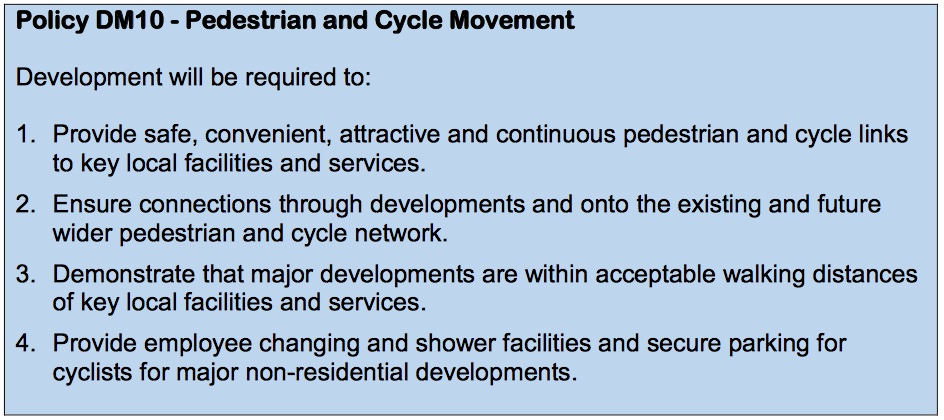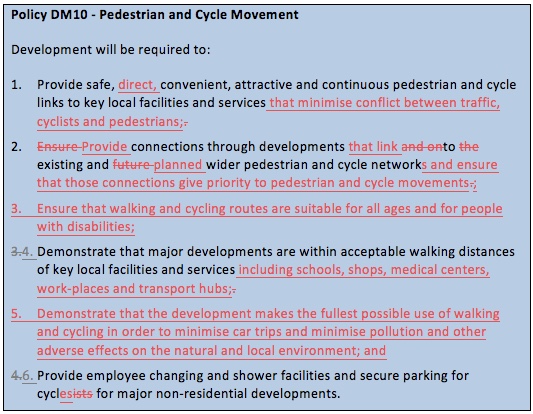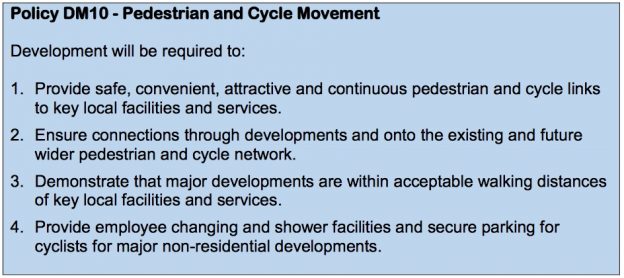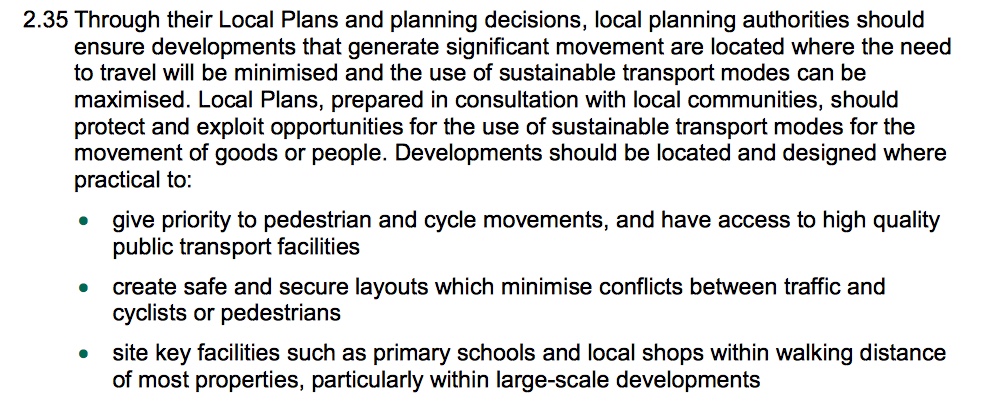
As part of its draft Development and Allocations Plan, Newcastle City Council has set out the detail policies that it believes will help it achieve the objectives set out in The Core Strategy and Urban Core Plan, and which together will guide how the city is to be developed up to 2030.
In this second blog on the draft DAP we want to look at proposed policy DM10 covering pedestrian and cycle movement.

You can comment on the new plan on the Let’s Talk website until 20 November 2017. Our previous blog on the proposed policy for Protecting Open Spaces is here.
The Overwhelming Case for Walking and Cycling
In our post The Case for Healthy Streets we set out much of the evidence for why walking and cycling should be prioritised when considering new transport schemes, including the benefits to health and the economy, in creating more and better choices for how we travel and for children’s independence and safety. New policy should therefore require best practice for walking and cycling provision to ensure that maximum benefits can be gained for the city and its residents.
DAP policies also have to be consistent with the National Planning Policy Framework (NPPF) and other national legislation. It also needs to be consistent with The Core Strategy and Urban Core Plan, which has already defined the strategic objectives (S07, S08) and policy (CS13) that this more detailed policy is to support.
Getting this right is very important as we saw at Gosforth Business Park where a poor design would almost certainly lead to much more traffic passing through the South Gosforth Air Quality Management Area.
The SPACE for Gosforth Proposal
Broadly we support the new policy however we wish to propose some amendments in particular to ensure anyone can use new walking and cycling routes and to avoid conflict between people walking and cycling.
We have set out these changes below shown in red and underlined along with supporting evidence to show that the proposals are consistent with the NPPF and the Core Strategy.
- Direct routes that also minimise conflict between walking and cycling.

The Newcastle Core Strategy Policy CS13 section 3(vii) requires that development “provides for direct, safe, secure and continuous pedestrian and cycling links.” Policy DM10 should therefore be updated to also require that routes are direct to support this.
NPPF Section 35 requires that developments be designed where practical to “create safe and secure layouts which minimise conflicts between traffic and cyclists or pedestrians, avoiding street clutter and where appropriate establishing home zones.” The NPPF is right to say that danger mostly comes from conflict with vehicles but routes should also be designed to avoid conflict between people walking and cycling.
Safety in this context means both from vehicle traffic and also ensuring people feel safe from crime. So, for example, unlit alleyways would not be appropriate.
2. Giving priority to walking and cycling

Section 35 of the NPPF also says where practical to “give priority to pedestrian and cycle movements, and have access to high quality public transport facilities;” Updating the policy to include this priority will help make walking and cycling viable choices for local journeys, where often design is currently an after-thought leading to long circuitous routes and long waits at multi-stage crossings.
This is also consistent with the Core Strategy Section 11.12, which states that “The aim of the Plan is to create sustainable communities, centres and new developments where priority is given to sustainable modes of transport. The hierarchy of sustainable modes of transport is: walking, cycling, public transport (including taxis), freight, car traffic.”
3. Ensuring walking and cycling routes are suitable for all ages and abilities
![]()
Section 1(i) of Core Strategy Policy CS13 requires the council to promote “sustainable travel choices including … improving equality of access to transport for everyone“. We wish to propose this addition as ensuring equality of access to transport is a key part of SPACE for Gosforth’s objectives.
As per those objectives ‘everyone’ includes “all ages and abilities.” and “residents or visitors with limited mobility and residents or visitors with disabilities or conditions for whom travel is a challenge.” For examples of how hard it can be to navigate some local streets see the SPACE for Gosforth blogs on Gosforth High Street and the Salters Road junction.
Core Strategy Policy CS14 – Wellbeing and Health backs this up by stating “The wellbeing and health of communities will be maintained and improved by … Requiring development to contribute to creating an age friendly, healthy and equitable living environment through: i. Creating an inclusive built and natural environment” and “ii. promoting and facilitating active and healthy lifestyles.” Core Strategy Policy CS15 Place-Making also requires development to create “safe and inclusive environments“.
Although a fairly weak statement, NPPF paragraph 35 requires that where practical developments should “consider the needs of people with disabilities by all modes of transport.” Also, one of the objectives of the Government’s Cycling and Walking Infrastructure Strategy (CWIS) is “better integrated routes for those with disabilities or health conditions”.
Much stronger still is The Equality Act 2010, which the RNIB summarise as follows. “It is unlawful for a public authority to discriminate in the exercise of its public functions. This includes highways functions. Section 20 (4) requires that where a physical feature (which includes increases in traffic) puts a disabled person at a substantial disadvantage in comparison to a person who is not disabled, an authority is required to take such steps as is reasonable to have to take to avoid the disadvantage.”
4. Clarifying a minimum list of local services

This policy is derived from NPPF paragraph 38 which mentions schools and shops: “For larger scale residential developments in particular, planning policies should promote a mix of uses in order to provide opportunities to undertake day-to-day activities including work on site. Where practical, particularly within large-scale developments, key facilities such as primary schools and local shops should be located within walking distance of most properties.”
As the purpose of the DAP is to expand on the objectives set out in the Core Strategy we wish to clarify what the minimum set of services that people can walk to should be. The full list we propose are from the SPACE for Gosforth objective 3: “There is good walking and cycling access to local community destinations including schools, shops, medical centres, work-places and transport hubs.” This should be the minimum for any new development.
5. Making walking and cycling the natural choice for short to medium journeys

We wish to propose this new paragraph to include a number of NPPF and Core Strategy objectives to maximise the use of walking and cycling in order to minimise the impact of the development on the wider road network and public health.
NPPF paragraph 17 states that one of the core principles for planning is to “actively manage patterns of growth to make the fullest possible use of public transport, walking and cycling, and focus significant development in locations which are or can be made sustainable;” Only by making the fullest possible use of walking and cycling can the wider negative impacts be minimised.
Newcastle Core Strategy CS13 section 3(ii) supports this by “Ensuring development … minimises car trips, promotes and enhances public transport and for major development provides sustainable travel plans“. (Public Transport is covered in the DAP by a separate policy DM11.)
NPPF paragraph 110 states “In preparing plans to meet development needs, the aim should be to minimise pollution and other adverse effects on the local and natural environment.” This is very relevant to transport as it is both a significant contributor to local air pollution and to a number of other adverse effects including noise.
Consistent with all the above, the Governments’s Cycling and Walking Investment Strategy (CWIS) sets out “the government’s ambition to make cycling and walking a natural choice for shorter journeys, or as part of longer journeys“. Planning for new developments will be a key part of enabling this to happen.
6 Secure parking for cycles (not cyclists)

Our proposed change to section 6 is to provide cycle parking (in the same way as we have car parking and not motorist parking).
The full proposal is as follows. SPACE for Gosforth will be providing this response to the DAP consultation as well as commenting on other policies related to SPACE for Gosforth’s objectives.
Policy DM10 – Pedestrian and Cycle Movement (SPACE for Gosforth proposal)
Development will be required to:
- Provide safe, direct, convenient, attractive and continuous pedestrian and cycle links to key local facilities and services that minimise conflict between traffic, cyclists and pedestrians;
- Provide connections through developments that link to existing and planned wider pedestrian and cycle networks and ensure that those connections give priority to pedestrian and cycle movements;
- Ensure that walking and cycling routes are suitable for all ages and for people with disabilities;
- Demonstrate that major developments are within acceptable walking distances of key local facilities and services including schools, shops, medical centers, work-places and transport hubs;
- Demonstrate that the development makes the fullest possible use of walking and cycling in order to minimise car trips and minimise pollution and other adverse effects on the natural and local environment; and
- Provide employee changing and shower facilities and secure parking for cycles for major non-residential developments.

References to Planning from The Cycling and Walking Investment Strategy



